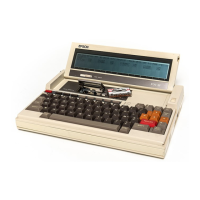REV.-A
Table
6-3
Special
Jigs
Name Standard
O'ty
Use
Commercial-
Iyavailable
*Extension cable (16-pin)
B778400701
1 Between MAPLE board and
LCD
NO
unit
*Extension cable (20-pin)
B778400601
1 Between MAPLE board and
NO
microcassette
*Extension cable (11-pin)
B778400801
1 Between MAPLE board and
NO
microcassette
Azimuth tape Olympus OA-211 1 Adjustment and inspection
of
YES
B777600101
microcassette
P
reel
torque check cassette Sony
TW-1112A
1 Adjustment and inspection
of
YES
B777600201
m icrocassette
RS-232C MINI WRAP
B778401101
1
NO
Serial MINI WRAP
B778401001
1
Adjustment
of
azimuth
NO
External speaker connector
B778400201
1
Adjustment
of
azimuth
NO
Key
top puller
B765000001
1
Key
top removal
YES
Microcassette tape
(EPSON
Y202503000
1 Microcassette tape read/write
YES
C-30) test
Test program
ROM
B778401201
1
Repair
NO
Table
6-4
Oil, Grease,
and
Chemicals
Name Standard
O'ty
Use
Commercial-
Iyavailable
Flux remover
--
1
YES
Instantaneous cooling agent
--
1
SOLDERING
YES
Alcohol
--
YES
Silicon lock
--
6.3
Soldering
Inaduertant soldering
of
delicate component can cause
component
damage. Carefully read and
fllow
the reccauting in Section 6.2.1
for
component removal and soldering
to
safeguard the Maple
computer's circuitry.
6.3.1
Removing
and
Installing
Parts
(1) When removing parts such
as
IC's, transistors, etc. from the board, cut the lead wires
of
the
parts
with
nippers and remove
the
solder.
Melt
the solder rapidly
to
prevent the parts from ab-
sorbing the heat.
(2) Solder each part quickly and use cooling agents
to
cool the part (to
protect
the parts and print-
ed circuit board).
(3) When removing parts, remove the solder from the holes using SOLDER REMOVER; pull
out
the lead wires,
which
were cut
in
advance. This should
be
done
without
excessive use
of
force
in
order
to
protect
the land and
print
pattern from being removed.
6-3

